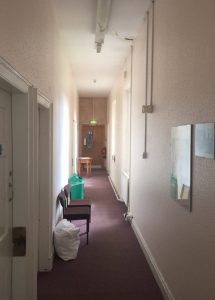Once, one of the “characters” died of old age, in his bed. His heart stopped. I heard the emergency call, and was told to rush up the stairs with the defibrillator, which in those days was the size of a fridge. The cables and paddles fell off and got tangled in my legs. When I finally got to the “chronic” ward it was, of course, too late. The ward staff were stricken with grief. “Good old_____” said one of the Nursing Assistants, “…he was a perfect patient, he was. He never shit the bed once.” You have to believe me when I tell you that the staff were genuinely upset by the death, and that the Nursing Assistant’s comment was meant as an expression of his admiration for the old guy. With such modest levels of acceptable behaviour, it is hardly surprising that we created a group of patients whose behaviour was totally unfit, and never would be fit, to survive in the outside world.
So we don’t do that anymore. In fact we hardly ever admit anybody at all, if we can help it; and even when we do it is for the shortest time possible, lest the toxins of the institution affect them. This is undoubtedly a good thing, and yet I worry, because I have a personal conviction that the outside world is as much a deforming institution as Whitchurch Hospital and its like ever was.
It is true that, as with many old institutions, Whitchurch was built on the outskirts of the city so that the unpalatable fact of mental illness could be kept at a distance and not cause offence. It is also true that the city then advanced to encompass the area of Coryton, and for most of the last hundred years the denizens of Whitchurch and Coryton have had to live with the redbrick spider and its green-domed water tower looming over them. It is fair to say that the local residents have coped quite well with this terrible burden. People who do not live in such circumstances are faintly discomfited by the idea—it must be like living next to a high security prison or a nuclear reactor: you are always waiting for the breach of protocol that leads to the escape of convict or radiation, or lunatic. But the locals in Whitchurch know the same thing that the locals in Cefn Coed or St. Cadocs also know: that the presence of an old psychiatric hospital in your village means precisely nothing; it is almost boring, because when the in-patients come out to shop or visit the pub or bank, it is a complete non-event. There is a disappointing lack of strangeness about those who have been diagnosed as mentally ill.
But people want it to be strange. Back in 1983 I had been out on the town one evening and had taken a taxi back to the Homes. Somewhere along North Rd., Drive said to me: “So you lives in Whitchurch ‘Ospital, then, is it?”
I replied in the affirmative. Drive narrowed his eyes a bit, gave this some thought, then asked his question: “Something I’ve always wondered about that place,” he said, “do you ‘ave much trouble with ’em howling in the night?”
I replied in the negative. He was clearly disappointed. He wanted, no doubt, tales of awesome lunacy, but I had none to tell.
Here is another memory from 1983. Every Saturday night, the Great Hall would be pulsing with pop music and chatter, and there would be a beery odour. Not a patients’ social function, not a staff reunion. The corridors would be full of drunken, unfamiliar people. Whitchurch Hospital was hired out on Saturday nights for wedding receptions; now, almost a quarter of a century on there must be at least some of those marriages surviving, with their memories of one humid and crapulent night in Whitchurch. It does seem an odd thing to do, and it hasn’t happened for some time, and yet only last week I was driving through the hospital’s main entrance and had to halt the car because of two young men in kilts posing with a bride and groom against a wedding car full of flowers and ribbons, a professional photographer snapping athletically away. How did people come to that decision? Where shall we have the reception, love? Where do you fancy for the photos? Castell Coch? Cathays Park? Cardiff Bay? I know, how about…
I suppose it just supports my contention that a psychiatric hospital is an ordinary place. Nothing, as Phillip Larkin said, like something, happens anywhere. And it’s as good a place as any to hold a wedding reception.
I moved out of Whitchurch for several years. Of course it wasn’t the same when I came back. It was falling to bits for one thing. Like the coal industry, it no longer has a place in somebody’s particular vision of the future, and so it has been neglected and is showing the terrible signs of that neglect.
As a Mental Health Professional whose teeth are getting quite long, I must applaud the closure of Whitchurch Hospital as a symbolic sweeping aside of the ancient asylum culture, clearing the way for a new build that will be fit for humans to inhabit. And I do applaud it. But it will be an ordinary building, the new one, a competent building; you and I know that it will possess not one hundredth of the aesthetic power and romance of Whitchurch Version 1.0. It will lack strangeness. Some of the old building is “listed”, and therefore parts of it will continue to exist to accommodate the flatlets or shopping centre or office facilities that are planned for the site, but it will be unrecognisable. It is difficult to see how the village of Whitchurch itself will retain its sense of character, unless the Water Tower is to remain.
I moved to Whitchurch Hospital to start my Registered Mental Nurse training when I was nineteen. A little room in the East Homes was pretty much my first experience of independent living.
But the nurse education went on in a building on the other side of the site, in a squat 1950s block. So my lessons were spent with a panoramic view of the hospital and the grounds. I started my training in February 1983. I was overwhelmed by two things: the little jars of real foetuses in the glass-fronted cabinet at the back of the classroom (I have never been able to work out what they had to do with psychiatry), and the view of the hospital with the trees in front of it. In February, the trees were bare and exhibited intricate branch-networks against a white sky, like the diagrams of bronchi, arteries and nerves I was being shown in anatomy lessons. At the age of nineteen, I thought I had been transported into the heart of a massive poem, and am still haunted by that time. If the new flats or offices find that they have a ghost, it may well be mine.
Thank you to Mark Doherty, follow Mark on twitter (@markdoherty1)

